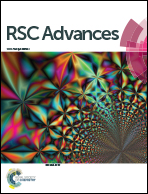Magnetic hollow carbon microspheres as a reusable adsorbent for rhodamine B removal†
Abstract
Magnetic hollow carbon microspheres (MHCMs) were fabricated with a dual alternative constitution of cavities and porous carbon shells by a combination of microwave-assistant polycondensation and surfactant-free emulsion polymerization. The MHCM was characterized by transmission electron microscopy, X-ray diffraction, thermogravimetric analysis, vibrating sample magnetometry and N2 adsorption/desorption isotherms. The MHCMs possessed features of uniform morphologies, high surface area (680 m2 g−1), large pore volume (0.61 cm3 g−1) and magnetic responsiveness. The MHCMs were used as an adsorbent to remove rhodamine B (RB). The removal efficiency of RB reached 99.5% and the adsorption capacity of the MHCMs reached as high as 300 mg g−1. The adsorption process followed the Langmuir isotherm very well. The enthalpy change was 28.35 kJ mol−1. The negative free energy change indicated that the adsorption process was feasible and spontaneous. The positive entropy change showed that there was an increase in disorder in the adsorption system. The removal process was endothermic and interaction controlled. The adsorption kinetics fitted well with the pseudo-second-order kinetics model. The removal efficiency of RB remained over 90% after six consecutive cycles, which demonstrated the high adsorption performance and favourable reusability of the MHCMs.



 Please wait while we load your content...
Please wait while we load your content...